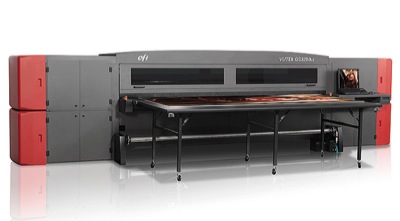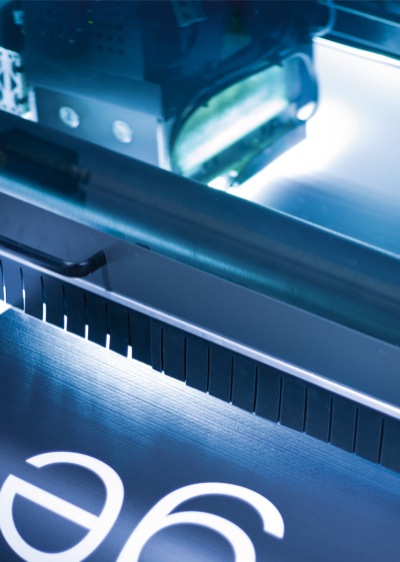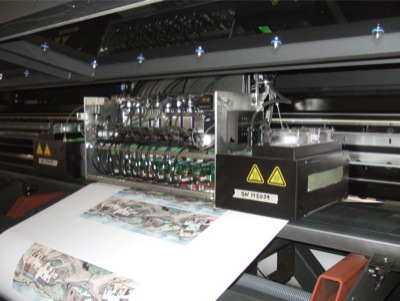EFI VUTEk GS3250LX in action
The benefits of LED curing are now a reality for EFI VUTEk users, giving them a wider range of substrates to choose from, and therefore more applications to offer.
EFI believes in the maxim of giving its customers a choice, and that this is dependent on various criteria according to what type of output is needed, both at the current time and in the future.
With green principles and greater adherence to environmental conditions now becoming more topical, eco factors also have to be considered when making the decision about which wide format printer to choose. Considerable publicity has been given in recent times to the incorporation of LED lamps in UV-curable print platforms of all types and sizes, yet few manufacturers thus far have included them as options in their wide format engines.
Early on, EFI recognised the potential and the benefits of offering its customers an alternative to mercury arc curing lamps, and this led to the development and subsequent introduction of the VUTEk GS3250LX 3.2 metre solution and the more recent two metre GS2000LX.
A major element leading to the adoption of LED curing has arisen because of the undisputed disadvantages of mercury arc lamp technology, including its relatively high toxicity and the generation of high levels of infrared heat. Because LED lamps emit UV within a very narrow band of wavelengths, there is no infrared present and the subsequent reduction in heat is a key contributor to the reasons why this alternative curing methodology is proving so successful on UVcurable printers.
Across Europe, companies have invested in the VUTEk GS3250LX because they have been actively seeking a more environmentally friendly UV-curable printer.
Feedback has confirmed that, for these businesses, choosing this platform which uses LED curing instead of conventional mercury arc lamps has opened up a whole new raft of materials which previously could not be printed and cured successfully using this ink formulation.
Formerly, problems have arisen because any substrate or surface which is intolerant of heat is going to suffer detrimental effects when it meets a conventional UV curing lamp.
The results can be badly buckled and warped substrates; worse, undesirable head crashes can bring damage to the printer itself. The VUTEk GS3250LX has quickly made a name for itself in being able to work with difficult media, with its ‘cool cure’ technology meaning that even the most unlikely materials can be handled.
As well as being suitable for use with thin stocks, one company has even discovered that it can print direct to bubblewrap with excellent results. This means that the use of LED UV lamps in an industrialstrength wide format printer now enables print service providers to experiment with different types of substrate and come up with novel and innovative production ideas that have not been possible before.
 EFI VUTEk GS3250LX
EFI VUTEk GS3250LX
Rumours that speed and efficacy are both compromised with LED curing are also unfounded. The throughput speeds of the VUTEk GS3250LX and its smaller counterpart match those of equivalent printers using mercury arc lamps, with high quality colour accurate results being guaranteed. Users have also commented that adhesion is excellent with EFI’s inks, and that the print heads tend to stay cleaner for longer periods because the lamps’ instant start-up means that they can be switched off between print runs.
The economics of the VUTEk GS3250LX also appeals to companies wanting to reduce the running costs and energy levels of their production equipment. Mercury arc curing lamps lose their quality of emission and their power over a finite amount of usage and period of time, having a typical life span of only 1000 hours.
The start-up time needed for them to reach maximum intensity also wastes power and is time consuming. However, LED curing arrays have an instant warm-up so can be turned on and off when needed. Their solid-state construction means that they should be able to produce tens of thousands of hours of active life, yet they cost a fraction of the price in power terms, with users reporting vastly reduced electricity bills.
For companies wanting to invest in a VUTEk printer and opting for versatility and overall cost savings, along with the greener properties achievable with LED curing, then there is the choice of the GS3250LX 3.2 metre wide platform or the two metre GS2000LX.
Those that feel more at home with a machine containing conventional lamps can aim for the 3.2 metre VUTEk QS3 Pro or the smaller QS2 Pro at two metres. Adding the option of EFI’s Orion architecture will bring additional benefits such as greyscale printing to all of these printers, along with other features including lower ink usage and remote diagnostics.
 A close up of the LED curing process
A close up of the LED curing process
Mercury lamps versus LED curing
Mercury vapour lamps distribute their energy over a broad spectrum of 200-800 nanometers, and only 5% of the energy generated is used for actually curing the UV ink, while the remaining 95% is converted into heat.
This heats the inks and substrates, especially the lamp housing, where fans suck the heat from the mercury vapour lamps. Therefore, many large format printers work with open panels.
The dissipated heat cannot be captured well and heats the entire press, which is not beneficial. LEDs are semiconductor elements that are applied to a substrate. The exact composition of these materials determines, among other things, the wavelength at which the LED has its greatest power output, so today a wide selection of diodes with wavelengths from the visible to the ultraviolet range is offered.
For UV inks there are UV-LEDs with a peak in the range of 395 and 365 nanometers, which are both used for UV inks. However, these LEDs emit considerably less light and therefore need to be assembled in the LED lamps in several rows to a surface light.
They also generate heat. It is estimated that 20% of UV radiation is used for curing and 80% of the visible light is converted into heat. This heat can be dissipated by air or water cooling, to avoid heating of the substrate.
Based on usage 12 hours a day, five days a week, and 52 weeks per year, curing with mercury vapour lamps consumes 46,800 kilowatt hours. For LEDs, at 80% utilisation the printing time is 9.6 hours x 3.6 kW, which equals 3.456 kWh per day.
For 5 day weeks and 52 weeks per year, the LED therefore consumes about 9,000 kilowatt hours a year. So 37,800 kilowatt hours can be saved annually with LEDs, in comparison with mercury vapour lamps.





